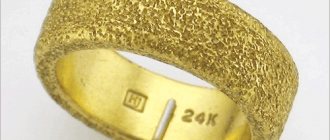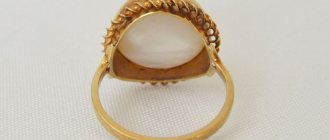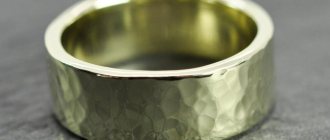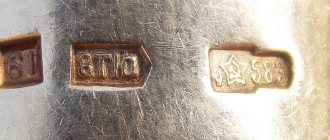We are all already accustomed to gold jewelry that people wear everywhere. However, one of the most amazing and unusual alloys used for jewelry production today is the so-called white gold. The hallmarks of white gold are no different from the usual, familiar yellow metal, and correspond to the content of precious material in the final product. Let's see what types of white aurum exist.
Gold items have always been a sign of wealth and belonging to the highest strata of society. Nowadays, such jewelry also symbolizes the wealth of its wearer, but their appearance has undergone significant changes. Due to the fact that ordinary pure gold is a very soft metal, to give it hardness, various alloys are added to jewelry alloys, which transfer some of their properties to the material.
What types of white alloy are there?
How spoiled we are! Sellers offer purple gold, and black, green, blue, purple... White gold is especially loved by swindlers. After all, it is easy to obtain a white inexpensive alloy and then pass it off as a low grade of precious metal. Let's see what types of white precious alloy there are.
375 and 500
Pass by if you see such numbers on the stamp - it's a fake. There is not a single “working” alloy with such a gold content, the color of which would be white with a light yellow tint, and the product itself would be durable.
585
Most often, white gold of this standard contains nickel, which negatively affects health. The yellowness is more pronounced.
750
The best sample of a precious metal product. The ligature often contains palladium or platinum, so the jewelry is more expensive.
925
White gold with this hallmark is not produced.
958
Sample for banking precious metal, pure, practically free of impurities. Conventionally white color is given by the alloy components. Therefore, if they offer to buy “a very rare 958 white alloy,” hold your wallet tight—they are scammers.
Sample determination methods
Jewelers have long simplified their lives. If it is known for sure that the jewelry contains gold (I already wrote about the touchstone in one of the articles), the guys use the pan-European standard for gold alloys EN 28654. This is an addition to the ISO 8654: 1987 standard “Colors of gold alloys. Definition. Shades of colors and designation."
All colors are divided into 6 groups. Each has an interval of trichromatic coordinates. Using the table of values, the correspondence of the color (and alloy) of the sample to the standard is determined. Chemical reagents are not used to determine the sample.
Of course, the appraiser at the pawnshop tries to play it safe. You can check the authenticity and determine the composition of the alloy and coating using detectors, for example, Gold Detector GS 2532 or Gold Detector WgD 00.
Which sample is the best?
I look at the table of the most common grade of ZlMNTs alloy (gold/copper/nickel/zinc).
| Try | Gold, % | Copper, % | Nickel, % | Zinc, % | Others, % |
| 750 | 75 | 15 | 7,5 | 2,5 | — |
| 750 | 75 | 12,5 | 10 | "Footprints" | 0.03 Re |
| 585 | 58,3 | 25 | 12,5 | 4,2 | — |
| 585 | 58,3 | 16,2 | 17 | 8,5 | — |
| 585 | 58,3 | 22 | 14,7 | 4,8 | 0.2 manganese |
The least amount of nickel, which causes allergies, is in the white alloy 750 (and in general just gold). In addition, the alloy itself is stronger. Therefore, the higher the sample, the better.
Looking ahead, I will say: for the “noble” precious metal, nickel is replaced with palladium and other metals. In this case, a product made of white gold of the same standard will cost more.
Kinds
Jewelry is in demand in any economic situation, so the sample is important for those who buy jewelry to save and increase money. It should be borne in mind that jewelry made from this metal varies significantly in price categories. The cost just depends on what grade of white gold a particular piece of jewelry is.
Many people who are not appraisers or jewelers often only know that a product should be hallmarked, but what it is remains a secret. In fact, this concept means nothing more than the amount of gold itself or other precious metal contained in one gram of the alloy. There is one more concept that is important for determining the cost of finished jewelry - ligature. This word hides a certain number of additives included in gold for the production of jewelry.
Composition and properties of white gold
The white alloy has its own division into “classes”:
- noble;
- ignoble.
The composition of the ligature and the resulting properties of the two groups are different. Noble metal is obtained by alloying with silver, platinum and palladium.
Ignoble contains:
- based on silver, nickel, copper;
- zinc (added to the alloy to improve casting properties).
What is responsible for color
Each metal adds certain properties. White color is obtained by adding palladium, platinum and nickel.
Durability and scratch resistance
Hardness and scratch resistance while maintaining ductility are the merit of nickel. Due to this metal, the base white alloy is 2 times stronger and harder than the noble one.
Everything would be fine, but jewelry, due to the nickel oxide formed on the surface, causes allergies in many people when worn for a long time. Therefore, the global trend is moving towards noble white gold (with an increase in cost due to expensive components in the alloy).
Shade range
The color of any white alloy (in accordance with ISO 8654: 1987, European standard EN 28654) is characterized by a yellowish tint. The degree of yellowishness depends on the “nobility”. If two identical white gold rings are placed side by side, the “noble” one will have a lighter yellowish tint.
I looked at the top 10 articles about white alloy. The phrase “the color of white gold can be pale pink or pale brown” is a lie (see standard). And further.
White gold products are not plated with rhodium:
- colored gold was specially developed by jewelers;
- this is not economically viable (cheaper silver is used for rhodium).
Main differences between precious metals
The white appearance of the precious metal in comparison with platinum can be distinguished by paying attention not only to the color, but also to the chemical composition. Colorless gold contains additives of other metals, but platinum does not contain them. So, the manufacturer can make inclusions of nickel, and this, in turn, quite often provokes allergic reactions. If platinum is added to the main material, then you don’t have to worry about allergies - it doesn’t cause them.
There are practically no small parts in platinum products, since this natural material is very durable and difficult to process. Jewelry made from pure platinum is very expensive and often has its own hallmark. It will be difficult for a non-professional person to distinguish platinum from colorless gold. When purchasing, you should always ask for documents for the product, and also look at the hallmark.
How do you get it?
For a person far from alloy technology, jewelry making seems simple. I threw pieces of metal into the crucible according to the proportions, put them on the burner, mixed them and cast the decoration. Unfortunately, metals are characterized by different melting temperatures: gold is already gurgling with might and main, but copper continues to float in pieces.
The production of noble white gold is possible at a temperature of about 1000 °C, base gold - 600...700 °C (annealing). Additionally, reagents are used (for example, boric acid), so the presence of other impurities is specified in the recipe. After annealing, the alloy is cooled slowly to prevent cracking.
This is how two alloys with different physical properties are obtained:
- Plastically deformable (based on Au, Ag, Pd). It is used for the manufacture of blanks by sheet stamping or manual processing.
- Casting alloy (Au, Cu, Ni, Zn). Used for precision casting workpieces.
The history of the appearance of white jewelry alloy
Products made from white gold were delayed for a decade. They appeared in the collections of jewelry houses after the end of the First World War.
First, craftsmen began to actively use platinum: at the beginning of the 20th century. The “garland style” came into fashion (founder Louis Cartier). Silver is a soft metal. To make the product stronger, it was necessary to duplicate the frame with gold. The jewelry turned out to be massive and uncomfortable to wear.
In 1910, Diaghilev's Russian Ballet performed in Paris. “Scheherazade”, with its luxurious decorations and rich multi-colored robes, made such a strong impression on the public that oriental motifs, Turkish trousers and colorful robes came into fashion.
Jewelers begin to conduct “chromatic experiments,” but the war cancels out all plans. Platinum disappears from the market (used in the military industry), and England imposes an official ban on trade in this metal.
After the war, fashion changes: the geometric linear design of gold jewelry requires a modern color scheme. Then brooches, bracelets, clips, and “collars” appear en masse. At the peak of popularity, women's wristwatches in white gold cases (it would enjoy similar success in the 1990s).
Where is white gold used?
Any colored gold is intended for mass-produced jewelry. Made from white:
- jewelry with stones;
- “mix” in combination with individual gold elements of a different color;
- cigarette cases, medals, watch cases.
How did this alloy come about?
In the first half of the 20th century, many European jewelry lovers fell in love with this metal for its color, which looked ideal in combination with pearls and diamonds.
At that time, silver alloys were often used, but silver was not of very good quality, so high society chose jewelry products made from white precious metal with the addition of nickel. But it turned out that the latter causes allergic reactions and is not suitable for jewelry making. In our country, an admixture of copper was added to the composition, which gave the jewelry a reddish tint and did not look decent. This type of precious metal in Russia is still produced today with low-quality silver alloys. Such products, which have a purity of 375 and 500, should be treated with caution .
Advantages and disadvantages of white gold
Alloy advantages:
- Suitable for cold working, casting and casting for setting stones.
- Does not crack when the temperature rises (suitable for annealing and soldering).
- Visually increases the value of jewelry stones, making the appearance of the product more luxurious.
Main disadvantages:
- The alloy is very hard, so processing difficulties arise. Hence the simple design solutions for jewelry.
- It is unlikely that you will be able to melt scrap on your own.
- Precious metal is difficult to work with, so jewelers have problems when working (private craftsmen are understandably reluctant to work with it).
- Upon contact with skin, nickel in the ligature (regardless of the sample) causes an allergic skin reaction.
Widespread use of 750 gold
Precious metals are in demand in many areas. Also, 18k white gold is used for the production of various products, due to its physical properties. This metal is used in jewelry, various industries, and dentistry.
It is used in the manufacture of electrical components.
Gold in electrical parts
Why jewelers love him
Yellow metal 750 is fusible and quite soft. Thanks to this, it is easy to work with, it is easy to polish jewelry, and give the material the desired shape. It is used in the production of decorative elements for luxury stationery, household items, and electronics.
Some things are made entirely from this precious metal: pens, cufflinks, watches, etc.
White gold
An alloy based on the yellow precious metal and platinum, palladium is one of the most in demand today. It may look different depending on the presence of coating. It is easy to determine whether there is a layer of rhodium by looking at the shade: such jewelry is distinguished by a purer white color and shines. But the surface must be periodically restored, as it loses its properties. 18k white gold looks best when combined with:
- diamonds;
- red, yellow inserts;
- unusual carving.
Combination with stones
I get aesthetic pleasure just looking at a professionally cut gem. “Lights” appear inside, the stone attracts with the play of colors. But once it gets fixed, the magic is often lost. The jewelers knew about this.
Therefore, before the use of “paws” back in the 18th century. Foil was placed under the stone to enhance its reflective properties. And in the 19th century. even diamonds were set into silver overlays.
Nowadays white gold is used for these purposes. The stone is fixed “on legs” (light enters from all sides), and the beam reflected from the surface creates an additional stream of light. A not so expensive insert looks more attractive, the shade of the stone becomes richer, closer to the standard (for example, a diamond with yellow tint).
White gold of any standard favorably highlights the beauty of the stone under one condition: the jewelry insert must be transparent (the precious metal is usually not used, for example, with turquoise or coral).
Fashion trends
The peak of popularity of the new alloy of the original shade occurred in the 20s of the last century. Consumers noted the harmonious combination of the new metal with precious stones. It hid the yellowness of not too pure diamonds, emphasized the coldness of sapphires, revealed the inner beauty of rubies and allowed us to look at emeralds in a new way. The neutral white color of the jewelry also looked good with a variety of outfits. Unlike silver, 585 white gold was not covered with a black patina and retained its charming shine even after prolonged wear.
But the new alloy had one significant drawback - its price. Jewelry made from it was more expensive than from ordinary gold. With the increase in the cost of platinum, chemists began to actively look for a worthy alternative. Silver was not even considered in this capacity, since in order to achieve a beautiful white color, it had to be added in excess quantities. Otherwise, the alloy was more like the color of light wood.
375 gold, which would really be white, contains so much argentum that it can be called silver.
After much experimentation, it turned out that adding platinum to Au compounds is not the only way to achieve beautiful coloring in jewelry. 14k white gold may contain other impurities. For example, nickel, manganese, and zinc have performed well in this regard. The use of these metals directly or as a secondary brightener in gold alloys has served as a new stage in the development of the jewelry industry.
How to distinguish a fake from the original
The buyer does not carry reagents in his purse to the store. To distinguish a fake from an original, you should carefully examine the product.
The jewelry is marked:
- The types of stamps for each metal are different. Any product made of white gold in the Russian Federation must have the following mark:
- shaped like a spatula;
- a clear drawing of a girl in a kokoshnik;
- sample number 750 and 585;
- the letter in front of the picture is the code of the State Inspectorate of Assay Supervision.
- To the left or above the sample there must be a nameplate (numbers and letters of the name of the manufacturer, year of manufacture of the jewelry). The manufacturer's mark is approved and published by the Ministry of Finance of the Russian Federation.
A product purchased abroad may bear a “general mark” (by the way, it is placed at the request of the client). The “scales” pattern is used, mainly on watches. White gold products with such a hallmark are original, since the “common hallmark” was adopted in the EEC at the Vienna Convention to facilitate trade in jewelry.
There may be a print with the image of the rising sun and the sample number. Products with it are also original, and the drawing belongs to the international association Emagold (120 countries).
In order not to be deceived, especially for tourists, I recommend that you check the official state stamp before the trip (for example, an eagle in France).
How to distinguish white gold from silver and platinum
In addition to different markings (stamp), all of the listed products differ in color. White gold of any standard has a yellowish color. Silver is characterized by its silvery-white color, while platinum is naturally pure white (“steel-like”) in color.
What is the price of jewelry products
Several important factors influence the cost:
- what additional metals are included in the composition;
- what percentage of pure gold does it contain;
- What is the fineness of white gold?
- Product parameters (weight, execution technique, etc.)
If we take the average parameters, then the price of this precious alloy is per 1 gram. ranges from 2100 to 3500 rubles.
Whatever jewelry you choose, it is important to treat it with care and, if necessary, polish it in a jewelry workshop no more than once a year. A new layer of metal can be applied to items coated with rhodium if it has worn off, and then your favorite rings, earrings, bracelets and pendants will continue to delight themselves with their “lunar” noble radiance.
Tips for choosing white gold jewelry
My jeweler friend recommends:
- choose 750th sample - it is stronger than 585th;
- look for nickel-free ligature (require a certificate for the product, not a tag);
- check for the presence of a mark.
Decorations in the following styles remain popular:
- minimalism;
- naturalism (flowers and leaves) with oriental ornaments;
- mix (several shades of gold at once).
The main thing is that you should like the jewelry to the point of butterflies in your stomach - girls understand what I mean.
By the way, it is not recommended for children, teenagers and people with unstable mental health. Precious metal spoils character and gives an illusory reason to look down on people.
Strengths and advantages
With the admixture of high-quality metals, a more noble composition is obtained, suitable for making jewelry. This metal is easy to process and retains its shape for a long time. Not only the beauty of the white appearance of the precious metal helps to make a product unique, but also the fact that many types of precious stones can be set in it very easily. It is in combination with colorless gold that products with stones are most often found. The noble metal harmoniously sets off the jewelry stone with its light. Several types of metal give gold an attractive white hue:
- silver;
- platinum;
- palladium;
- zinc;
- nickel.
Where can you buy or sell
Products made of 585 or 750 carat white gold are offered by jewelry houses, small shops and websites:
- jewelry, especially with stones, looks respectable;
- The fashion trend is to decorate yourself with gold of different colors.
Although self-respecting stores practice buying items back, it is difficult to sell even 750-karat jewelry for an adequate price. Pawn shops only take into account the weight (scrap), often without the work of a jeweler, the artistic value and carat of the stone. It is more common to buy traditional red or yellow gold “from hand”; They look askance at white.
You can try placing an offer at an auction (both in real life and online) or look for a client on specialized sites.
My advice: keep all tags and certificates for the product - having documents will speed up the sale.
White gold price per 1 gram
The price of white gold per 1 g depends on:
- From the sample. So, in a 2 g product, gold of 750 purity is 1.57 g, and gold of 585 purity is 1.176 g. With external similarity and the same weight, the former will cost more.
- Because of the “nobility”, platinum (palladium) additions raise the price.
- From gold exchange rate quotes.
This is the lower bar (for buying). Further, the price of the product includes work, production costs, sales margin, advertising, brand... Therefore, by the way, jewelry is not suitable for investment - there are too many unnecessary components in the price.
I looked at the sites of purchases and pawnshops - they don’t highlight white gold as a separate line, they give a general table. Which, in general, is logical - no matter what the additives are, the percentage of solar metal is the same.
| Try | Price, rub./g |
| 585 | 1770–1775 |
| 750 | 1950–2050 |
How to determine gold purity?
Testing gold without a sample is not that difficult. Jewelers will accurately determine the value of the product and give a guarantee. This is the simplest and most reliable solution. But if you want a more serious approach, then the Russian State Assay Office can accept individuals. There they will help you determine the sample and put a damaging stamp on it.
Brand on jewelry
If you want to sell your jewelry, it would be better to go to a pawnshop. There they will be able to accept gold without assay and determine its value. In order to hand over your jewelry, you only need a passport. And if you change your mind, you can buy it back within two months. Convenient pawn shops operate in Sunlight stores, where gold items in any condition can be returned for exchange.
If you want to find out the gold sample at home, then there are several ways to determine the noble metal:
- A method known for a long time is testing with vinegar. Dip a gold item into the solution and get results almost immediately. Gold does not change its color.
- Another popular method is checking with a magnet. If the item is well magnetized, then it is made of steel or gold plated, because real gold is not attracted to a magnet.
- Gold, like all money, does not smell, unlike any other metal.
- If you have unfired ceramic tiles, rub the product against it. Are the marks left dark or gray? Then it's not gold.
- Powder for cauterizing wounds, lapis, can also reveal the nobility of metal. Apply a little lapis to the wet product. If it turns black, it is a fake.
However, you will not be able to accurately determine the gold sample at home, because... special materials are needed: gold chloride, nitric acid and an assay needle.
Tips for care, cleaning and storage
I have written a short reminder on caring for white gold jewelry - use it.
- Every thing has its place! Jewelry is not stored in bulk; it is carefully laid out in compartments so as not to damage the stones or scratch the surface.
- Precious metal is covered with craters under the influence of acids or hot alkali. Therefore, wash the jewelry with soapy water without aggressive chemicals. Rinse with warm water and polish with a flannel.
- It is acceptable to use dry tooth powder or gruel with water for cleaning.
Compatibility with precious stones
Jewelers have known for a long time that a white backing enhances the reflective properties. Even semi-precious stones will appear in a more favorable light, which is important if a person decides to sell a product and get a good price for it. This may mean that the decoration needs to be presented properly. The stone will look more attractive if it has a white metal setting.
It used to be considered fashionable to use silver for this purpose. Later - platinum. Since the appearance of a white gold alloy, it has become widely used for the production of jewelry with stones. In Russia, jewelry factories often use this metal in combination with inserts from:
- diamond (white, colored);
- emerald;
- grenade;
- pearls;
- topaz;
- sapphire.
Reviews
I managed to find inside information about white gold. Think before placing an order from an unfamiliar jeweler.
Buy factory-made products or from a famous foreign brand (Cartier jewelry house, for example). Then the decoration will not crumble or become covered with cracks.
How to choose real 750 gold
If you have not previously had experience purchasing high-quality products, you must take into account the following recommendations:
- you should buy jewelry from trusted manufacturers, in large jewelry stores;
- if you have any suspicions about the low quality of the products, you can ask for a certificate;
- you need to inspect the jewelry: there should be no damage on the surface, pay attention to the weight (gold jewelry is heavier than silver), such jewelry has a bright shine;
- the shade may be different (not pure yellow, but with a pinkish, green tint), but this does not mean low quality, the metal simply differs in the ratio of the ligature.











